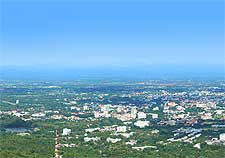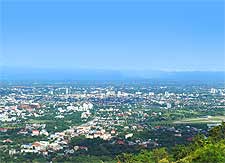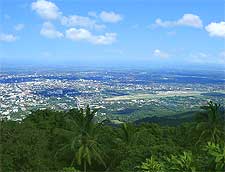Chiang Mai History Facts and Timeline
(Chiang Mai, Thailand)

The capital city of the ancient Kingdom of Lanna, Chiang Mai lies in the far north of Thailand, along the banks of the Mae Ping River. Founded in 1296 by King Mengrai, the old walled city is a haven of Buddhist temples, some almost as old as the city itself.
The Lanna Kingdom was independent until 1768, when it became a tributary of Siam, although it was not fully incorporated into Thailand until 1939. Chiang Mai is intensely proud of its long history and heritage, with Lanna Thai still spoken in the city. Even today, the original square-mile Old Town is surrounded by its historic moat and well-preserved corner bastions and gates, making it a real cultural gem.
Early Settlement and the New City
Settlement in the region of Chiang Mai began around 5,000 years ago, although most migration took place during the Mongol incursions into northern Burma and the Shan States. Today's Thai came from a linguistically grouped ethnic community, who migrated south into the area at the end of the first millennium. The Lanna Kingdom arose as the earliest true kingdom of present-day Thailand. King Mengrai was already a powerful ruler, with his first city at Chiang Rai to the North and contacts with other local rulers.
After his conquest of the Haripunchai (Hariphunchai) Kingdom in nearby Lamphun, Mengrai chose the site of his 'new city' capital, Chiang Mai, in 1292. This location was selected since it offered a good trade link between goods coming down the Mekong River, which could then be transferred to the Ping River, ready to journey further south.
Within ten years, the city was sending trade missions to the Chinese court, but not before the present city had to be relocated from the flooded site of the first settlement. Only recently were these ruins discovered beneath lychee plantations south-west of the city, and today they have been excavated as a tourist attraction known as Wieng Khum Kham.

Warfare and Renewal
By the 14th and 15th centuries, King Mengrai's 'new city' had shattered into conflict with its neighbours and within itself, due to the lack of a suitable successor to the highly talented Mengrai. After a ten-year fight for the throne, King Tilok (Tilokaracha) saved Chiang Mai from invasion by Ayutthaya (Ayuddhaya). Tilok went on to conquer nearby regions in preparation for the predicted war with Ayutthaya, which arrived in 1456, finally ending in stalemate some 30 years later, in 1486. Three famous Chiang Mai temples, the Wat Chedi Luang, the Wat Jed Yod and the Wat U Mong (Umong) were erected during this period.
A Golden Era
The subsequent reign of King Muang Kaeo (Muang Kaew) was a cultural and religious golden period of history for Chiang Mai, focused on Buddhism, with new temples and glorious Buddha images appearing. During this time, the city hosted the World Council of Buddhists at the Wat Jed Yod temple. Chaos, however, returned after Muang Kaeo's death, again caused by the lack of a suitable successor, and resulted in an Ayutthaya invasion and civil war.
History of the Burmese Years
By the mid-16th century, Chiang Mai had weakened financially and in 1558, the Burmese invaded. Burmese administrators and garrisons were installed and, by the time Ayutthaya fell in 1767, Chiang Mai was all but deserted. Shortly after, the Siamese regrouped from the sacking of present-day Ayutthaya and established a new capital in
Bangkok. They sent a Northern general, Kawila, to retake the city for the Thai, which was achieved in 1775.

A Deserted City
Although Chiang Mai was continually attacked by Burmese forces until 1800, it was still underpopulated after the threat had ended, necessitating forced repatriation.
Westerners began arriving in the mid-19th century, establishing rubber plantations and trading outposts, and a British Vice-Consul was appointed in 1884.
The 20th Century and Onwards
By now, Chiang Mai's royalty had lost most of its power due to unpopular reforms and increased taxes demanded by Bangkok. Transportation links improved with the railway in 1919 and, in 1939, the last Chiang Mai prince, Jao Kao Norawat, died.
Much remains of the city's fascinating history in its restored late 18th-century walls, numerous stunning temples and the living traditions of its inhabitants. The tallest structure in the Old Town is Wat Chedi Luang's pagoda, which was felled by a mid-16th century earthquake and is now only half of its original height of 92 metres / 300 feet.
In the early nineties, the city opened up to tourism and now serves as a springboard to the mountains of the region - and it has never looked back. It hosted the SEA Games in 1995 and today the city is part living museum and part provincial hub.
 The capital city of the ancient Kingdom of Lanna, Chiang Mai lies in the far north of Thailand, along the banks of the Mae Ping River. Founded in 1296 by King Mengrai, the old walled city is a haven of Buddhist temples, some almost as old as the city itself.
The capital city of the ancient Kingdom of Lanna, Chiang Mai lies in the far north of Thailand, along the banks of the Mae Ping River. Founded in 1296 by King Mengrai, the old walled city is a haven of Buddhist temples, some almost as old as the city itself.
